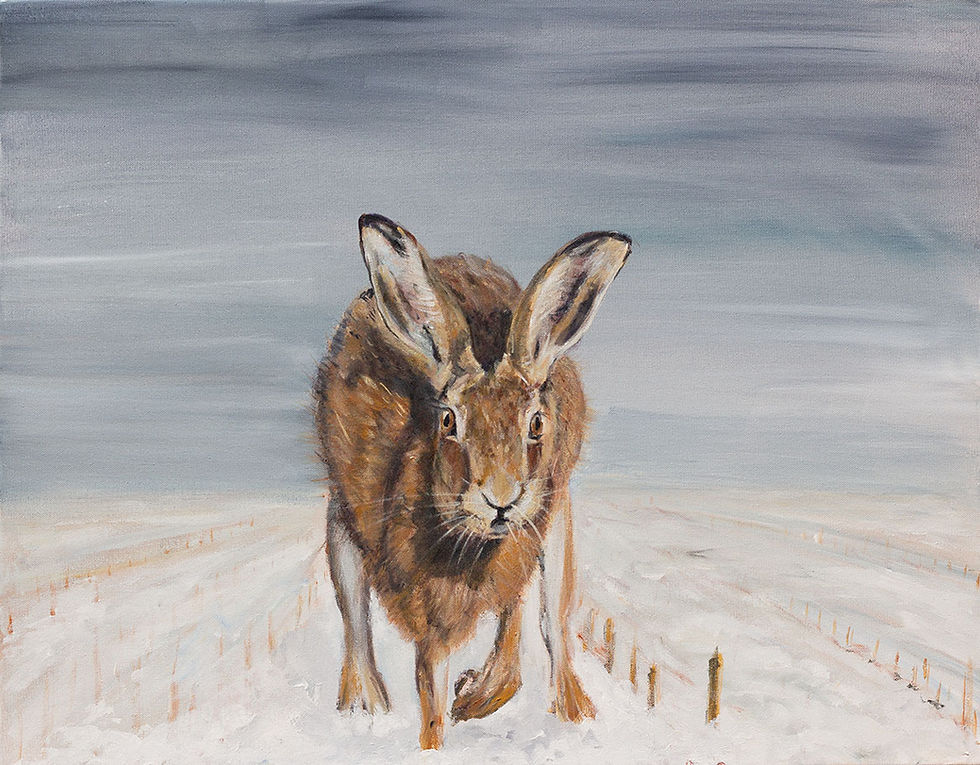The Enchanted Hares of the British Countryside: Nature, Folklore, and Art
- Jane Haigh

- Apr 28, 2024
- 4 min read
Hello, nature lovers and art enthusiasts! Today, let's hop into the magical world of one of Britain's most iconic and mystic creatures - the hare. These elusive animals have pranced through the British countryside and our imaginations for centuries, inspiring countless tales, artworks, and even a bit of folklore magic. As we explore the life of these fascinating creatures, we'll also discover how they've leapt into the heart of Jane Haigh's country art, capturing the essence of the British wilds.
A selection of greeting cards available on my website
Hares Through the Seasons: A Year in the Life
The life of a hare in the British countryside is a tale of adaptation and survival through the changing seasons. In the spring, the countryside bursts into life, and so does the activity of hares. This is the time of the famous "boxing" matches, where females (does) fend off overzealous males (bucks) or test the strength of their suitors. It's a spectacular sight that has fueled much of the mystique surrounding these animals.
As summer unfolds, hares enjoy the abundance of food, feasting on a variety of grasses and herbs. This is also when leverets (baby hares) are born, not in burrows, but in shallow depressions called forms. Remarkably, leverets are born fully furred and with their eyes open, ready to face the world from day one.
Autumn brings a change in the landscape, and hares begin to bulk up, preparing for the leaner months ahead. Their fur thickens, offering better camouflage and protection against the elements.
Winter sees hares becoming more nocturnal, conserving energy and foraging for food under the cover of darkness. Despite the bare and frosty landscape, hares are well-equipped to survive, their brown coats blending into the winter terrain.
The Mystic Nature of Hares
Hares have long been shrouded in mystique and folklore. In British folklore, hares are often associated with the moon, witchcraft, and transformation. The legend of the "witch's hare" tells of witches transforming into hares to roam the countryside unseen. Hares are also symbols of fertility and renewal, celebrated in springtime lore and linked to the pagan festival of Eostre.

Several hare prints are available to buy on my website
Where They Live and How They Look After Their Young
In the countryside, the hare lives a solitary life, very different from rabbits. It doesn't dig burrows but instead lives above ground. It spends its days resting in a shallow depression it scrapes out of the ground, called a form, which is just big enough for its body when it crouches down. This form can be located against a hedge, in short grass, among scrub, or in a ploughed furrow. When in its form with its ears flat, the hare blends in well with its surroundings.
If something disturbs it, the hare will stay very still, hoping not to be noticed. But if a predator gets too close, it quickly jumps up and runs away, using its speed to escape. Hares are very fast, thanks to their long hind legs and streamlined bodies, and can run up to 35 miles an hour. They often manage to outrun predators by suddenly changing direction and running in a zig-zag pattern.
The best times to see a hare are early in the morning or at dusk when it's out feeding. It often sits up to look around between eating. Its good sense of smell and hearing help it stay aware of predators. When moving across a field, a hare keeps low to the ground and moves slowly to avoid drawing attention.
Young hares (leverets) are all born in separate forms and attentive mother hares return to secretly suckle them undercover of dusk.

Jane Haigh Country Art: Capturing the Spirit of the Countryside
The elusive beauty and folklore of hares have found their way into the heart and art of Jane Haigh, a talented artist whose work celebrates the British countryside's wildlife. Through her country art, Jane captures the essence of hares, from their intense gazes to their dynamic movements, bringing the mystique of these creatures into homes and hearts everywhere.

This print, entitled "Daybreak"
was created to raise money
for a breast cancer charity.
Tags
Jane Haigh Country Art
British wildlife art
Hare folklore
Countryside art
Mystic nature of hares
Conclusion
The hare is more than just a creature of the British countryside; it's a symbol of the wild's mystique, a muse for artists, and a character of folklore. As we've journeyed through the seasons of a hare's life and explored the legends that surround them, it's clear that these creatures are as much a part of the British landscape as the rolling hills and hedgerows.
Through the art of Jane Haigh, we're invited to see the countryside through the eyes of one of its most enchanting inhabitants, reminding us of the beauty and mystery that surrounds us every day.
The Lincolnshire Wildlife Trust has some great information - you can even sponsor a hare.











Comments